sensor MITSUBISHI SHOGUN 2016 (in English) Owner's Guide
[x] Cancel search | Manufacturer: MITSUBISHI, Model Year: 2016, Model line: SHOGUN, Model: MITSUBISHI SHOGUN 2016Pages: 404, PDF Size: 18.95 MB
Page 208 of 404
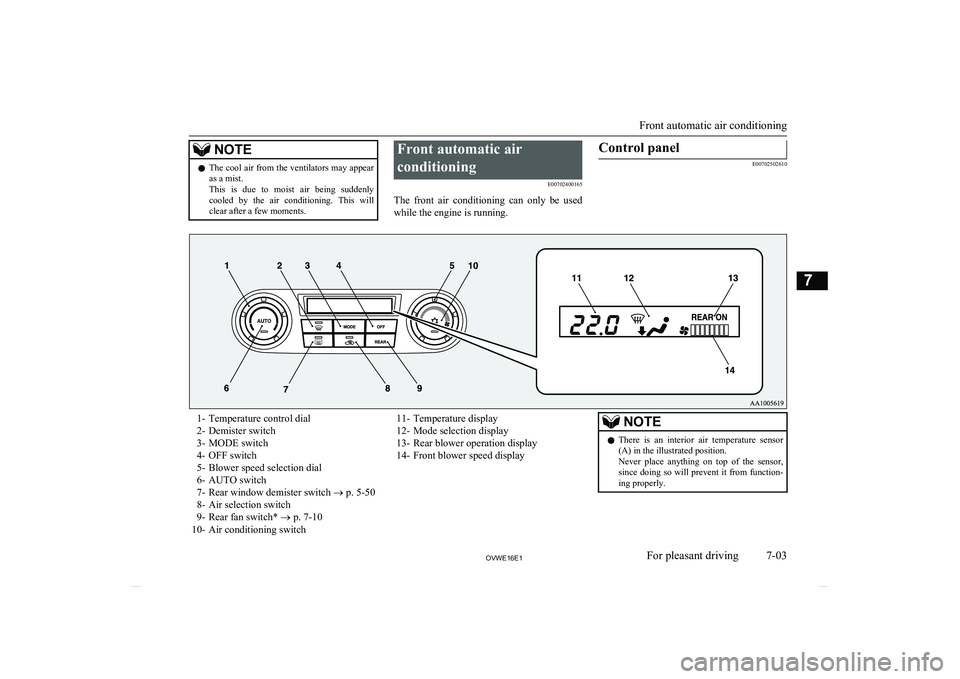
NOTElThe cool air from the ventilators may appear
as a mist.
This is due to moist air being suddenly
cooled by the air conditioning. This will
clear after a few moments.Front automatic air
conditioning E00702400165
The front air conditioning can only be used
while the engine is running.Control panel
E00702502610
1- Temperature control dial
2- Demister switch
3- MODE switch
4- OFF switch
5- Blower speed selection dial
6- AUTO switch
7- Rear window demister switch ® p. 5-50
8- Air selection switch
9- Rear fan switch* ® p. 7-10
10- Air conditioning switch11- Temperature display
12- Mode selection display
13- Rear blower operation display
14- Front blower speed displayNOTEl There is an interior air temperature sensor
(A) in the illustrated position.
Never place anything on top of the sensor,
since doing so will prevent it from function- ing properly.
Front automatic air conditioning
7-03OVWE16E1For pleasant driving7
Page 320 of 404
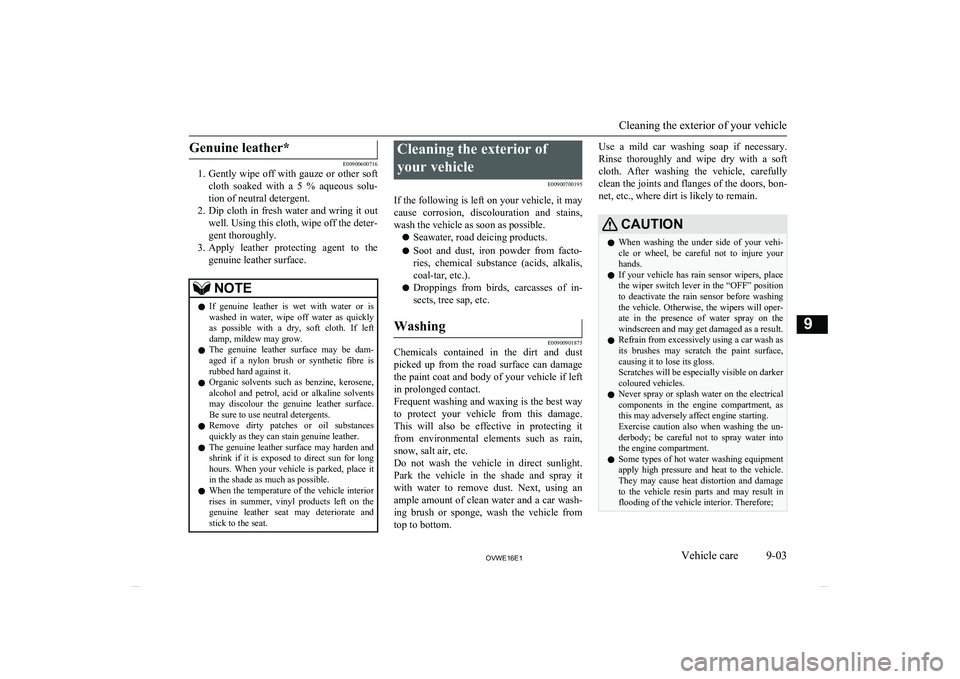
Genuine leather*
E00900600716
1. Gently wipe off with gauze or other soft
cloth soaked with a 5 % aqueous solu- tion of neutral detergent.
2. Dip cloth in fresh water and wring it out
well. Using this cloth, wipe off the deter-
gent thoroughly.
3. Apply leather protecting agent to the
genuine leather surface.
NOTEl If genuine leather is wet with water or is
washed in water, wipe off water as quickly
as possible with a dry, soft cloth. If left damp, mildew may grow.
l The genuine leather surface may be dam-
aged if a nylon brush or synthetic fibre is
rubbed hard against it.
l Organic solvents such as benzine, kerosene,
alcohol and petrol, acid or alkaline solvents
may discolour the genuine leather surface. Be sure to use neutral detergents.
l Remove dirty patches or oil substances
quickly as they can stain genuine leather.
l The genuine leather surface may harden and
shrink if it is exposed to direct sun for long
hours. When your vehicle is parked, place it in the shade as much as possible.
l When the temperature of the vehicle interior
rises in summer, vinyl products left on the
genuine leather seat may deteriorate and stick to the seat.Cleaning the exterior of
your vehicle E00900700195
If the following is left on your vehicle, it may cause corrosion, discolouration and stains, wash the vehicle as soon as possible.
l Seawater, road deicing products.
l Soot and dust, iron powder from facto-
ries, chemical substance (acids, alkalis, coal-tar, etc.).
l Droppings from birds, carcasses of in-
sects, tree sap, etc.Washing
E00900901875
Chemicals contained in the dirt and dust picked up from the road surface can damagethe paint coat and body of your vehicle if left
in prolonged contact.
Frequent washing and waxing is the best way to protect your vehicle from this damage.
This will also be effective in protecting it from environmental elements such as rain,snow, salt air, etc.
Do not wash the vehicle in direct sunlight.
Park the vehicle in the shade and spray it
with water to remove dust. Next, using an ample amount of clean water and a car wash- ing brush or sponge, wash the vehicle from
top to bottom.
Use a mild car washing soap if necessary.
Rinse thoroughly and wipe dry with a soft
cloth. After washing the vehicle, carefully clean the joints and flanges of the doors, bon-
net, etc., where dirt is likely to remain.CAUTIONl When washing the under side of your vehi-
cle or wheel, be careful not to injure your
hands.
l If your vehicle has rain sensor wipers, place
the wiper switch lever in the “OFF” position
to deactivate the rain sensor before washing the vehicle. Otherwise, the wipers will oper-ate in the presence of water spray on the
windscreen and may get damaged as a result.
l Refrain from excessively using a car wash as
its brushes may scratch the paint surface,
causing it to lose its gloss.
Scratches will be especially visible on darker
coloured vehicles.
l Never spray or splash water on the electrical
components in the engine compartment, as
this may adversely affect engine starting.
Exercise caution also when washing the un-
derbody; be careful not to spray water into the engine compartment.
l Some types of hot water washing equipment
apply high pressure and heat to the vehicle.
They may cause heat distortion and damage to the vehicle resin parts and may result in
flooding of the vehicle interior. Therefore;
Cleaning the exterior of your vehicle
9-03OVWE16E1Vehicle care9
Page 321 of 404
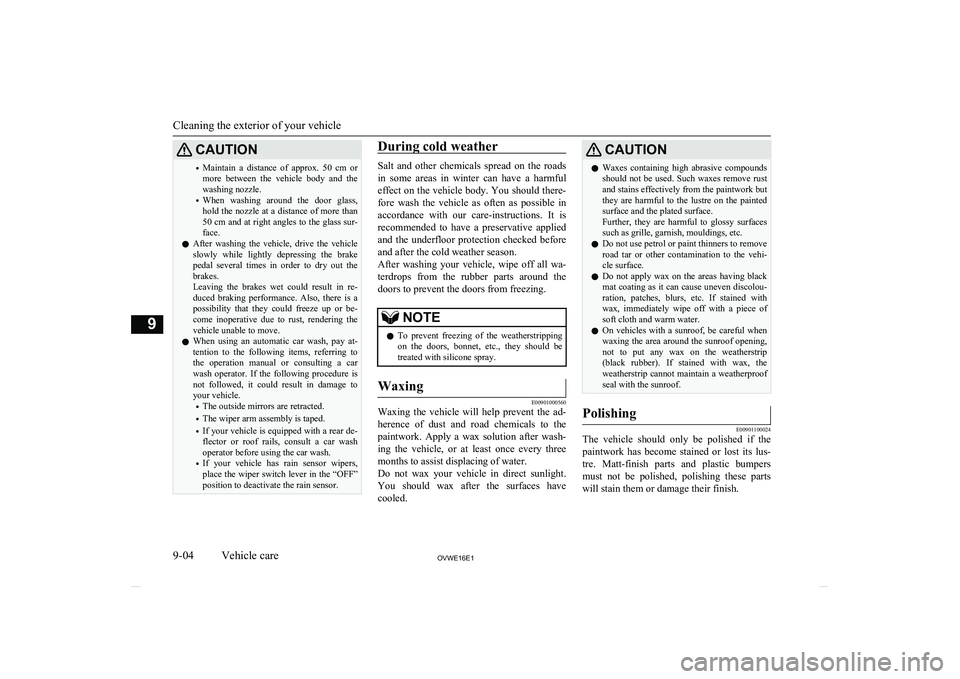
CAUTION•Maintain a distance of approx. 50 cm
or
more between the vehicle body and the washing nozzle.
• When washing around the door glass,
hold the nozzle at a distance of more than
50 cm and at right angles to the glass sur- face.
l After washing the vehicle, drive the vehicle
slowly while lightly depressing the brake
pedal several times in order to dry out the
brakes.
Leaving the brakes wet could result in re- duced braking performance. Also, there is a
possibility that they could freeze up or be- come inoperative due to rust, rendering the vehicle unable to move.
l When using an automatic car wash, pay at-
tention to the following items, referring to the operation manual or consulting a car
wash operator. If the following procedure is not followed, it could result in damage to
your vehicle.
• The outside mirrors are retracted.
• The wiper arm assembly is taped.
• If your vehicle is equipped with a rear de-
flector or roof rails, consult a car wash operator before using the car wash.
• If your vehicle has rain sensor wipers,
place the wiper switch lever in the “OFF” position to deactivate the rain sensor.During cold weather
Salt and other chemicals spread on the roads
in some areas in winter can have a harmful effect on the vehicle body. You should there-
fore wash the vehicle as often as possible in accordance with our care-instructions. It is
recommended to have a preservative applied
and the underfloor protection checked before and after the cold weather season.
After washing your vehicle, wipe off all wa- terdrops from the rubber parts around the
doors to prevent the doors from freezing.
NOTEl To prevent freezing of the weatherstripping
on the doors, bonnet, etc., they should be treated with silicone spray.Waxing
E00901000560
Waxing the vehicle will help prevent the ad-
herence of dust and road chemicals to the paintwork. Apply a wax solution after wash- ing the vehicle, or at least once every three
months to assist displacing of water.
Do not wax your vehicle in direct sunlight.
You should wax after the surfaces have
cooled.
CAUTIONl Waxes containing high abrasive compounds
should not be used. Such waxes remove rust and stains effectively from the paintwork but
they are harmful to the lustre on the painted
surface and the plated surface.
Further, they are harmful to glossy surfaces such as grille, garnish, mouldings, etc.
l Do not use petrol or paint thinners to remove
road tar or other contamination to the vehi-
cle surface.
l Do not apply wax on the areas having black
mat coating as it can cause uneven discolou-
ration, patches, blurs, etc. If stained with wax, immediately wipe off with a piece of
soft cloth and warm water.
l On vehicles with a sunroof, be careful when
waxing the area around the sunroof opening, not to put any wax on the weatherstrip
(black rubber). If stained with wax, the weatherstrip cannot maintain a weatherproof
seal with the sunroof.Polishing
E00901100024
The vehicle should only be polished if the
paintwork has become stained or lost its lus- tre. Matt-finish parts and plastic bumpers
must not be polished, polishing these parts will stain them or damage their finish.
Cleaning the exterior of your vehicle
9-04OVWE16E1Vehicle care9
Page 337 of 404
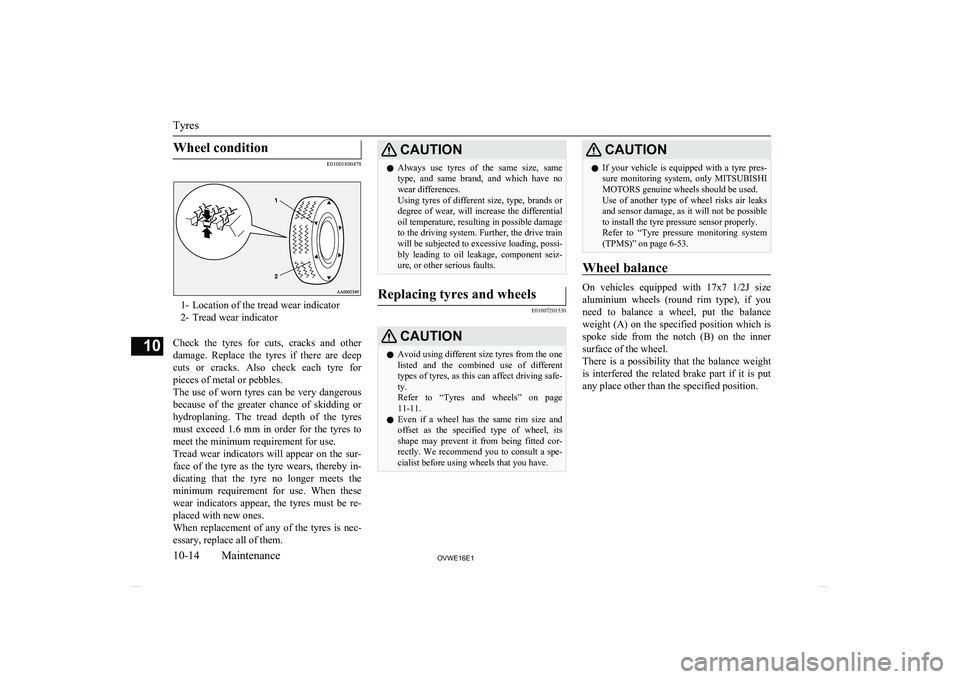
Wheel condition
E01001800478
1- Location of the tread wear indicator
2- Tread wear indicator
Check the tyres for cuts, cracks and other damage. Replace the tyres if there are deep
cuts or cracks. Also check each tyre for pieces of metal or pebbles.
The use of worn tyres can be very dangerous
because of the greater chance of skidding or
hydroplaning. The tread depth of the tyres
must exceed 1.6 mm in order for the tyres to meet the minimum requirement for use.
Tread wear indicators will appear on the sur-
face of the tyre as the tyre wears, thereby in-
dicating that the tyre no longer meets the
minimum requirement for use. When these wear indicators appear, the tyres must be re-
placed with new ones.
When replacement of any of the tyres is nec- essary, replace all of them.
CAUTIONl Always use tyres of the same size, same
type, and same brand, and which have no wear differences.
Using tyres of different size, type, brands or
degree of wear, will increase the differential
oil temperature, resulting in possible damage to the driving system. Further, the drive train
will be subjected to excessive loading, possi- bly leading to oil leakage, component seiz-ure, or other serious faults.Replacing tyres and wheels
E01007201530
CAUTIONl Avoid using different size tyres from the one
listed and the combined use of different
types of tyres, as this can affect driving safe- ty.
Refer to “Tyres and wheels” on page
11-11.
l Even if a wheel has the same rim size and
offset as the specified type of wheel, its
shape may prevent it from being fitted cor- rectly. We recommend you to consult a spe-
cialist before using wheels that you have.CAUTIONl If your vehicle is equipped with a tyre pres-
sure monitoring system, only MITSUBISHI
MOTORS genuine wheels should be used.
Use of another type of wheel risks air leaks and sensor damage, as it will not be possible
to install the tyre pressure sensor properly.
Refer to “Tyre pressure monitoring system
(TPMS)” on page 6-53.
Wheel balance
On vehicles equipped with 17x7 1/2J size
aluminium wheels (round rim type), if you
need to balance a wheel, put the balance weight (A) on the specified position which is
spoke side from the notch (B) on the inner surface of the wheel.
There is a possibility that the balance weight
is interfered the related brake part if it is put
any place other than the specified position.
Tyres
10-14OVWE16E1Maintenance10
Page 339 of 404
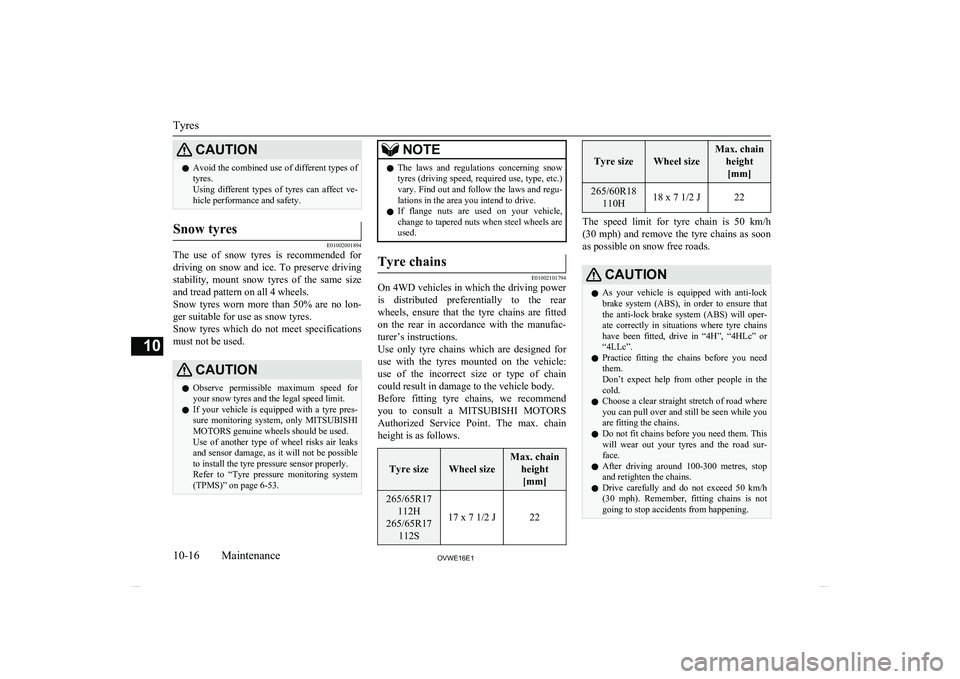
CAUTIONlAvoid the combined use of different types of
tyres.
Using different types of tyres can affect ve-
hicle performance and safety.Snow tyres
E01002001894
The use of snow tyres is recommended for
driving on snow and ice. To preserve driving stability, mount snow tyres of the same size and tread pattern on all 4 wheels.
Snow tyres worn more than 50% are no lon-
ger suitable for use as snow tyres.
Snow tyres which do not meet specifications must not be used.
CAUTIONl Observe permissible maximum speed for
your snow tyres and the legal speed limit.
l If your vehicle is equipped with a tyre pres-
sure monitoring system, only MITSUBISHI
MOTORS genuine wheels should be used.
Use of another type of wheel risks air leaks and sensor damage, as it will not be possible
to install the tyre pressure sensor properly.
Refer to “Tyre pressure monitoring system
(TPMS)” on page 6-53.NOTEl The laws and regulations concerning snow
tyres (driving speed, required use, type, etc.)
vary. Find out and follow the laws and regu- lations in the area you intend to drive.
l If flange nuts are used on your vehicle,
change to tapered nuts when steel wheels are used.Tyre chains
E01002101794
On 4WD vehicles in which the driving power
is distributed preferentially to the rear wheels, ensure that the tyre chains are fitted
on the rear in accordance with the manufac- turer’s instructions.
Use only tyre chains which are designed for use with the tyres mounted on the vehicle: use of the incorrect size or type of chain
could result in damage to the vehicle body.
Before fitting tyre chains, we recommend you to consult a MITSUBISHI MOTORS
Authorized Service Point. The max. chain
height is as follows.
Tyre sizeWheel size
Max. chain
height[mm]265/65R17 112H
265/65R17 112S
17 x 7 1/2 J22Tyre sizeWheel size
Max. chainheight[mm]265/60R18 110H18 x 7 1/2 J22
The speed limit for tyre chain is 50 km/h(30 mph) and remove the tyre chains as soon as possible on snow free roads.
CAUTIONl As your vehicle is equipped with anti-lock
brake system (ABS), in order to ensure that the anti-lock brake system (ABS) will oper- ate correctly in situations where tyre chains
have been fitted, drive in “4H”, “4HLc” or “4LLc”.
l Practice fitting the chains before you need
them.
Don’t expect help from other people in the
cold.
l Choose a clear straight stretch of road where
you can pull over and still be seen while you are fitting the chains.
l Do not fit chains before you need them. This
will wear out your tyres and the road sur-
face.
l After driving around 100-300 metres, stop
and retighten the chains.
l Drive carefully and do not exceed 50 km/h
(30 mph). Remember, fitting chains is notgoing to stop accidents from happening.
Tyres
10-16OVWE16E1Maintenance10
Page 377 of 404
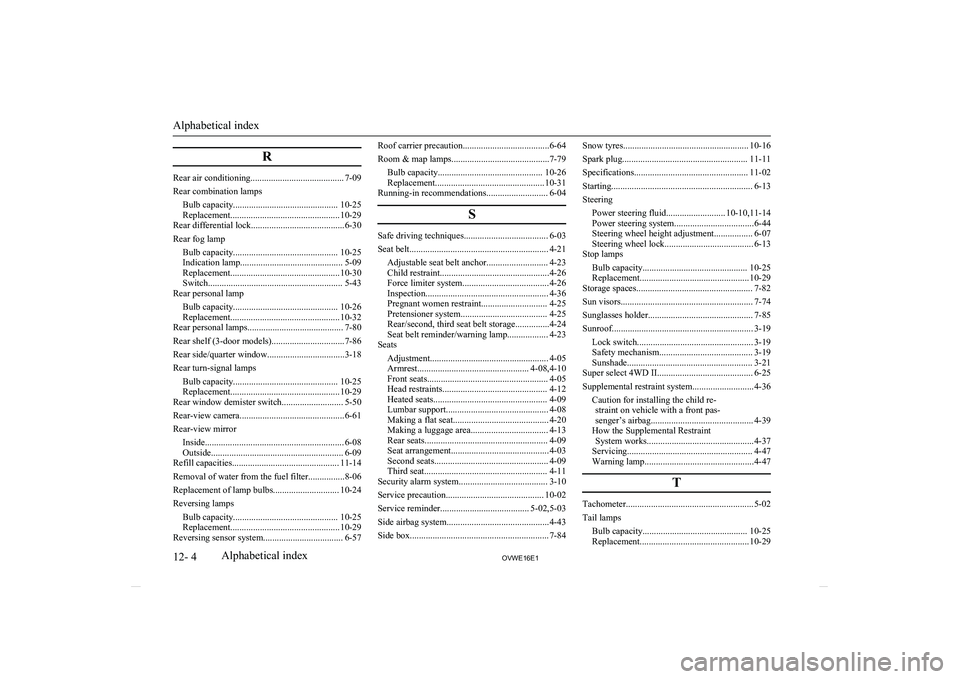
R
Rear air conditioning......................................... 7-09
Rear combination lamps Bulb capacity.............................................. 10-25
Replacement................................................ 10-29
Rear differential lock.........................................6-30
Rear fog lamp Bulb capacity.............................................. 10-25
Indication lamp............................................. 5-09
Replacement................................................ 10-30
Switch........................................................... 5-43
Rear personal lamp
Bulb capacity.............................................. 10-26Replacement................................................ 10-32
Rear personal lamps.......................................... 7-80
Rear shelf (3-door models)................................7-86
Rear side/quarter window..................................3-18
Rear turn-signal lamps Bulb capacity.............................................. 10-25
Replacement................................................ 10-29
Rear window demister switch........................... 5-50
Rear-view camera..............................................6-61
Rear-view mirror
Inside............................................................. 6-08
Outside.......................................................... 6-09
Refill capacities............................................... 11-14
Removal of water from the fuel filter................8-06
Replacement of lamp bulbs............................. 10-24
Reversing lamps Bulb capacity.............................................. 10-25
Replacement................................................ 10-29
Reversing sensor system................................... 6-57
Roof carrier precaution......................................6-64
Room & map lamps...........................................7-79 Bulb capacity.............................................. 10-26
Replacement................................................ 10-31
Running-in recommendations........................... 6-04
S
Safe driving techniques..................................... 6-03
Seat belt............................................................. 4-21 Adjustable seat belt anchor........................... 4-23
Child restraint................................................4-26
Force limiter system...................................... 4-26
Inspection...................................................... 4-36
Pregnant women restraint............................. 4-25
Pretensioner system...................................... 4-25
Rear/second, third seat belt storage...............4-24
Seat belt reminder/warning lamp.................. 4-23
Seats
Adjustment.................................................... 4-05
Armrest................................................. 4-08,4-10
Front seats..................................................... 4-05
Head restraints.............................................. 4-12
Heated seats.................................................. 4-09
Lumbar support............................................. 4-08
Making a flat seat.......................................... 4-20
Making a luggage area.................................. 4-13
Rear seats...................................................... 4-09
Seat arrangement........................................... 4-03
Second seats.................................................. 4-09
Third seat...................................................... 4-11
Security alarm system....................................... 3-10
Service precaution........................................... 10-02
Service reminder....................................... 5-02,5-03
Side airbag system.............................................4-43
Side box............................................................. 7-84
Snow tyres....................................................... 10-16
Spark plug....................................................... 11-11
Specifications.................................................. 11-02
Starting.............................................................. 6-13
Steering Power steering fluid.......................... 10-10,11-14
Power steering system...................................6-44
Steering wheel height adjustment................. 6-07 Steering wheel lock....................................... 6-13
Stop lamps
Bulb capacity.............................................. 10-25
Replacement................................................ 10-29
Storage spaces................................................... 7-82
Sun visors.......................................................... 7-74
Sunglasses holder.............................................. 7-85
Sunroof.............................................................. 3-19 Lock switch................................................... 3-19
Safety mechanism......................................... 3-19 Sunshade....................................................... 3-21
Super select 4WD II.......................................... 6-25
Supplemental restraint system...........................4-36 Caution for installing the child re-straint on vehicle with a front pas-
senger’s airbag............................................. 4-39
How the Supplemental Restraint System works...............................................4-37
Servicing....................................................... 4-47
Warning lamp................................................4-47
T
Tachometer........................................................ 5-02
Tail lamps Bulb capacity.............................................. 10-25
Replacement................................................ 10-29
Alphabetical index
12- 4 OVWE16E1Alphabetical index